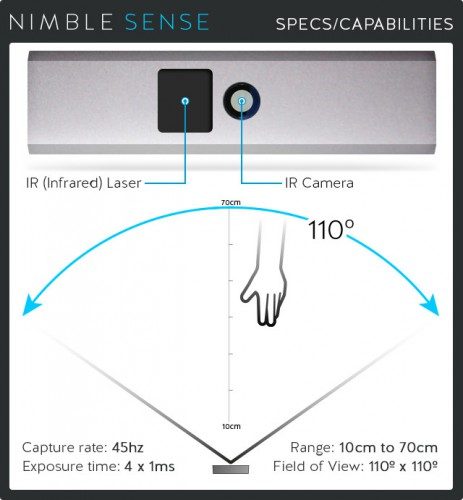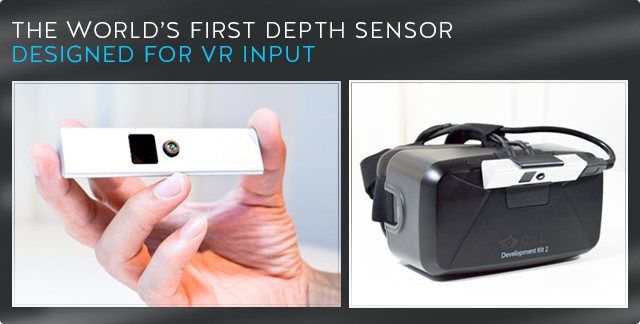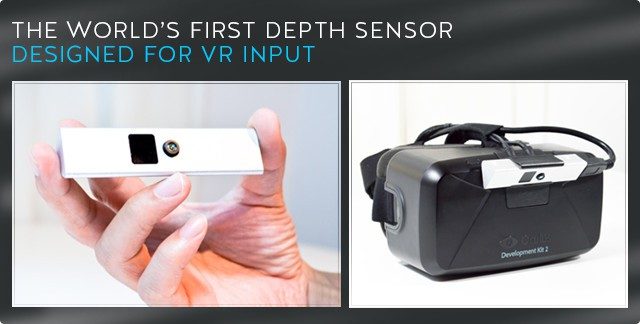Today Nimble VR launches a Kickstarter campaign for Nimble Sense, a natural input controller that the company says was designed for virtual reality input. And while Nimble Sense doesn’t at first appear to be much different than Leap Motion, the company says they’re using ‘time-of-flight’ depth sensing technology, like what’s used in the Kinect 2, which they say has unique benefits.
Nimble Sense uses an infrared laser to create a pulse of invisible light which illuminates the environment surrounding the user. An IR camera with a 110 degree field of view senses the light as it bounces off the environment and uses the known speed of light to work out the distance to discrete points in the environment. This allows the camera to capture a 3D model of the environment.
“Our camera captures a dense 3D point cloud every 20 milliseconds that can be used to bring not only hands, but arms, legs, and even your desk into VR,” Rob Wang, co-founder of Nimble VR, told me. “The 3D point cloud of the real world is rendered exactly at the right scale and location in VR—regardless of your IPD. The point cloud can even be shared and visualized by other users for multiplayer / social VR experiences.”
Wang notes that a stereo camera approach is necessarily locked to one IPD when it comes to viewing the outside environment.
“Competing cameras that use stereo imaging may only provide two infrared pictures, rather than dense 3D geometry. It’s harder to visualize a stereo image pair from a different user’s perspective, and stereo also assumes a specific IPD based on the spacing of the cameras.”
 Time of Flight at the Right Price
Time of Flight at the Right Price
Nimble VR says that they’ve “achieved a breakthrough in the accuracy, cost, and power consumption” of time-of-flight sensors, and they’re aiming to bring the tech to the world of VR at an affordable price point. For the first 500 backers, Nimble Sense starts at $99, which includes the camera and the DK2 mount.
The Nimble Sense Kickstarter campaign has a funding goal of $62,500 and the company expects to ship their product to backers in June of 2015. Nimble VR of course will also make available their SDK to allow developers to integrate the camera into their games and applications. The company is also planning to release four open source Oculus Rift demos to give developers a jump start on working with Nimble Sense.
VR Ready with DK1 and DK2 Mounts
Nimble Sense will ship with a mount for the Oculus Rift DK2 which smartly takes the place of the unit’s cable cover, meaning there’s no permanent modification needed to mount the sensor. The mount appears to cover two of the Rift’s IR LEDs, which are used for positional tracking, but like the Leap Motion VR Mount, it may not significantly detract from tracking performance.
Nimble VR also have a DK1 mount and desk mount available depending upon the Kickstarter backer level.
Nimble VR say they’ve been hard at work developing their skeletal hand-tracking technology to bring a user’s hands into the virtual environment. The unit has been designed to work best with objects that are 10cm to 70cm in front of the user, which the company says is the natural zone of interaction for the hands. They say that their hand-tracking tech is “the best in the world.”
Blair Renaud of Iris VR, developer of Technolust, sounds impressed by Nimble Sense. He’s quoted on the Kickstarter page as saying, “I’ve tried just about every VR control scheme out there, and I have to say that the Nimble Sense is by far the most promising I’ve tried so far.”
Nimble VR reached out early to a few VR developers, including Renaud, to demonstrate that the system can be integrated easily into existing projects.
The company doesn’t mention their latency, but from a brief video on the Kickstarter page, it appears on cursory inspection as passable.
Want to share your impression of Nimble Sense? Drop us a line in the comments!
Full Disclosure: Nimble VR is running an ad on Road to VR.








